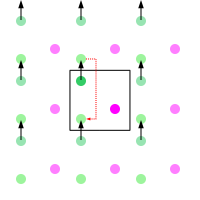Periodic boundary conditions

Okay kiddo, let's say you are playing with a ball in a room that has walls. The ball can only move around inside the room, right? But let's imagine the walls are made of special material that allows them to wrap around on themselves like a present. So if you roll the ball towards one wall, it will actually appear on the other side like magic!
This is kind of what periodic boundary conditions are for scientists who study things like atoms and molecules. Instead of a ball in a room, they are looking at really tiny things that move around inside something called a simulation cell. The simulation cell is like a tiny box that they can study the things in, but it has edges that would usually stop the things from moving past them.
But with periodic boundary conditions, those edges can wrap around on themselves like the walls in our imaginary room. So if an atom moves close to one edge, it pops up on the other side of the simulation cell, just like the ball in our imaginary room. This makes it possible for scientists to study how things move and interact without worrying about the edges of the simulation cell getting in the way.
So in summary, periodic boundary conditions are a special trick scientists use to study tiny things by making the edges of their little boxes wrap around on themselves like a present, just like how our imaginary room made it possible for a ball to magically appear on the other side of the wall.
This is kind of what periodic boundary conditions are for scientists who study things like atoms and molecules. Instead of a ball in a room, they are looking at really tiny things that move around inside something called a simulation cell. The simulation cell is like a tiny box that they can study the things in, but it has edges that would usually stop the things from moving past them.
But with periodic boundary conditions, those edges can wrap around on themselves like the walls in our imaginary room. So if an atom moves close to one edge, it pops up on the other side of the simulation cell, just like the ball in our imaginary room. This makes it possible for scientists to study how things move and interact without worrying about the edges of the simulation cell getting in the way.
So in summary, periodic boundary conditions are a special trick scientists use to study tiny things by making the edges of their little boxes wrap around on themselves like a present, just like how our imaginary room made it possible for a ball to magically appear on the other side of the wall.
Related topics others have asked about:
